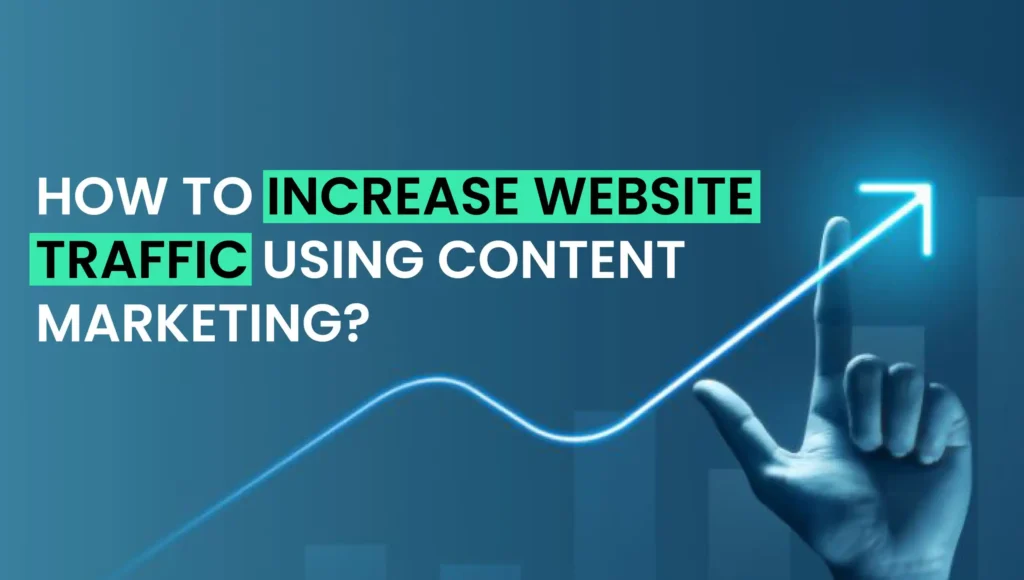If you’re looking to grow your website traffic and build a strong online presence, you’ve likely come across one key term that consistently stands out: content marketing. Content marketing is one of the most effective strategies for driving traffic, building authority, and fostering long-term relationships with your audience. But the real question is, how to increase website traffic using content marketing? In this blog post, I’ll share insights based on my real-world experience with clients and projects to help you understand how to leverage content marketing for organic traffic growth.
I’ve worked with multiple businesses in different niches, and one particular project stands out when talking about the success of organic content marketing. My team and I helped a local eCommerce brand increase its organic traffic by 230% within six months through an integrated content marketing strategy.
The focus was on creating content that not only resonated with the audience but also targeted the right keywords, optimized for search engines, and aligned with user intent. By utilizing the right approach, we managed to increase their organic search traffic and scale their online presence.
Now, let’s dive into how you can increase website traffic using content marketing and what strategies you need to follow.
Understanding Content Marketing
Before we jump into the strategies, let’s first understand what content marketing is and how it can help you increase organic traffic. Content marketing is the process of creating and distributing valuable, relevant, and consistent content to attract and engage a clearly defined audience. The ultimate goal is to drive profitable customer action.
When it comes to organic traffic, content marketing plays a crucial role. By producing quality content that answers questions, solves problems, and adds value to your audience, you can improve your rankings on search engines, which, in turn, increases the organic traffic to your site.
How Content Marketing Drives Organic Traffic
- SEO Benefits: Quality content that is optimized for SEO will naturally rank higher on search engines. With well-researched keywords and a focus on providing value to your audience, your content will appear in search results, driving organic traffic over time.
- Link Building: Creating high-quality, shareable content increases the likelihood of gaining backlinks from other authoritative websites. These backlinks signal to search engines that your content is valuable, which can boost your search rankings.
- User Engagement: Content that resonates with your target audience encourages engagement, such as social shares, comments, and return visits. Engaged users are more likely to convert, becoming long-term customers.
Conduct Keyword Research
One of the most important steps in how to increase website traffic using content marketing is keyword research. Without understanding what your audience is searching for, it’s impossible to create content that resonates with them.
I remember working with a client in the fitness industry. Initially, they had a great product but were struggling to generate traffic. Through keyword research, we found that there were several long-tail keywords related to their niche that had low competition but high search volume. By targeting these keywords in their blog posts, product descriptions, and landing pages, we were able to attract highly targeted visitors.
Steps for Effective Keyword Research:
- Identify Your Target Audience’s Needs: Think about what problems your audience is trying to solve or what questions they have. These can be turned into keywords.
- Use Keyword Research Tools: Tools like Google Keyword Planner, SEMrush, Ahrefs, and Ubersuggest can help you find high-volume, low-competition keywords.
- Focus on Long-Tail Keywords: These keywords may have a lower search volume but tend to convert better. Plus, they are less competitive.
- Analyze Competitor Content: Check what keywords your competitors are ranking for and find gaps that you can fill with your content.
Create High-Quality Content
One of the most powerful ways to increase organic traffic is to create content that answers your audience’s questions and solves their problems. Instead of just producing generic articles, make sure your content is comprehensive, well-researched, and provides actionable insights.
A great example of this approach was when I worked on a project with a tech client. They were offering a variety of products, but their content strategy was lacking. We created in-depth guides, how-to articles, and case studies around their products. These pieces were specifically designed to answer common customer questions, and we optimized them for how to get organic traffic through strategic keyword placement.
Tips for Creating Content That Drives Traffic:
- Focus on User Intent: Understand whether your audience is looking for information, solutions, or products. Create content that aligns with their intent.
- Be Comprehensive: Provide thorough, well-researched content that fully answers questions.
- Use Visuals: Infographics, videos, and images can enhance your content and improve user engagement.
- Update Old Content: Refresh outdated content by adding new information, optimizing it for SEO, and improving its readability.
Optimize Your Content for SEO
Simply writing great content isn’t enough. To increase organic search traffic, you need to make sure your content is optimized for search engines. This means using the right on-page SEO tactics, such as:
- Optimizing Meta Tags: Ensure your titles, descriptions, and headings are clear, and concise, and include your target keywords.
- Internal Linking: Link to other relevant pages on your website to boost SEO and keep visitors engaged.
- Image Optimization: Compress images to improve page load speed and add alt tags with relevant keywords.
- Mobile Optimization: Make sure your website and content are mobile-friendly, as this is a ranking factor for Google.
For example, when I worked with a client in the eCommerce space, we ensured every product page had optimized metadata, clear product descriptions, and internal links to related blog content. This approach increased their visibility on search engines and ultimately helped to increase organic traffic.
Promote Content Across Multiple Channels
Once you’ve created valuable content, don’t just wait for people to find it. Actively promote it across multiple channels to maximize your reach. Social media, email marketing, and partnerships can all help you get your content in front of the right audience and increase organic search traffic.
One strategy that worked particularly well for a client in the healthcare industry was repurposing blog posts into email newsletters, social media posts, and video content. This approach expanded the reach of their content and led to increased organic content marketing results.If you’re wondering how to increase organic traffic, focusing on multi-channel promotion and repurposing content can be highly effective.
Ways to Promote Content:
- Social Media: Share your content across platforms like Facebook, Twitter, LinkedIn, and Instagram to drive traffic to your website.
- Email Newsletters: Send your best content directly to your subscribers.
- Collaborations and Guest Posts: Write guest posts for other blogs in your niche to increase visibility and get backlinks.
6. Measure and Analyze Content Performance
Finally, it’s crucial to measure the performance of your content to understand what’s working and where you can improve. Use tools like Google Analytics, SEMrush, or Ahrefs to track the following metrics:
- Traffic Sources: Understand where your visitors are coming from.
- Bounce Rate: Monitor how many visitors leave your site after viewing only one page.
- Keyword Rankings: Keep track of how your content ranks for target keywords.
- Conversion Rates: Measure how your content converts visitors into leads or customers.
By analyzing the data, you can identify what’s driving the most traffic and replicate those strategies in future content.
Conclusion
Incorporating content marketing into your website’s growth strategy is essential for driving organic traffic. By creating high-quality, SEO-optimized content, targeting the right keywords, and promoting that content across the right channels—including social media marketing—you can significantly increase your website traffic over time.
Leveraging marketing hacks and optimizing for media traffic can further amplify your reach, ensuring that your content attracts and engages the right audience. Remember, there’s no quick fix or one-size-fits-all approach. Content marketing takes time, but with the right strategy in place, you’ll see long-term results.
By following the steps outlined above and focusing on high-quality content that aligns with user intent, you can achieve sustainable traffic growth. I’ve seen firsthand how effective this approach can be, particularly in my work with businesses across various industries. Just like the fitness client I mentioned earlier, you, too, can use organic content marketing to grow your online presence and increase traffic.
Now that you know how to increase website traffic using content marketing, it’s time to implement these strategies and start seeing results. Happy content creation!
FAQ:
What is a good increase in website traffic?
A good increase depends on your starting point and industry. Generally, a 10-20% monthly growth is considered strong. Consistent, quality traffic matters more than short-term spikes.
How can unique content be used to drive traffic towards a business?
Unique content attracts visitors by offering valuable insights, engaging storytelling, and solutions to problems. High-quality blogs, videos, and infographics improve SEO and encourage sharing.
What are the most effective ways to increase traffic to your website?
Effective strategies include SEO optimization, high-quality content creation, email marketing, PPC advertising, guest blogging, and influencer collaborations.
What are the advantages of increased website traffic for a business?
More traffic leads to higher brand visibility, increased leads, more conversions, and greater revenue potential. It also enhances credibility and customer engagement.
How much traffic can a website handle?
This depends on hosting capacity and server performance. Shared hosting can support thousands per day, while dedicated servers or cloud hosting handle millions.
How to get traffic to your website without social media?
You can use SEO, email marketing, content marketing, guest blogging, Google Ads, and partnerships to drive traffic without relying on social media.
How much traffic does your website need to make money?
It depends on your monetization model. Ad-based sites need high traffic (thousands per day), while service-based or e-commerce sites can profit from targeted lower traffic.
How to promote a new website?
Use SEO, PPC ads, guest blogging, email marketing, and directory listings. Engaging with niche communities and collaborating with influencers also helps.


